Groundcedar
(Diphasiastrum digitatum)

Description
Diphasiastrum digitatum is known as groundcedar, running cedar or crowsfoot, along with other members of its genus, but the common name fan clubmoss can be used to refer to it specifically. It is the most common species of Diphasiastrum in North America. It is a type of plant known as a clubmoss, which is within one of the three main divisions of living vascular plants. It was formerly included in the superspecies Diphasiastrum complanatum. For many years, this species was known as Lycopodium flabelliforme or Lycopodium digitatum. Its common name is due to its resemblance to cedar boughs lying on the ground. Its leaves are scale-like and appressed, like a mature cedar, and it is glossy and evergreen. It normally grows to a height of about four inches (10 cm), with the spore-bearing strobili held higher. This plant was once widely harvested and sold as Christmas greenery, and populations were widely depleted for this reason. However, it has recovered throughout its range, and makes large clonal colonies, carpeting the forest floor. Diphasiastrum digitatum is present in dry to mesic and usually acid forests and openings. They are located in the eastern part of North America including parts of Canada such as Ontario and Quebec and south to Florida and Louisiana.There are a variety of habitats for Diphasiastrum digitatum, but they are usually found in a partially shaded habitat that is moist to dry. Typically habitats are open forest, thickets, and fields. The sporulating season tends to be from July to October. Other habitats include upland woodlands, bluffs, sandstone cliffs, and abandoned sandy fields. They tend to be found in wooded areas where oak trees and conifers can also be found. It prefers disturbed areas and coniferous forests, where it can form dense monocultures. The subterranean, brown gametophytes may live for years in the soil before developing vegetative shoots. According to expert sources its range is in the higher Appalachian mountains northward, and its range ends in northern Georgia and Alabama, but isolated stands have sprung up elsewhere. The species Diphasiastrum digitatum belongs to the kingdom Plantae. Its subkingdom is Trachaebionta, its division is Lycopodiophyta. It falls in the class Lycopoiosida, order Lycopodiales, family Lycopodiaceae and the genus is Diphasiastrum L.
Taxonomic tree:







